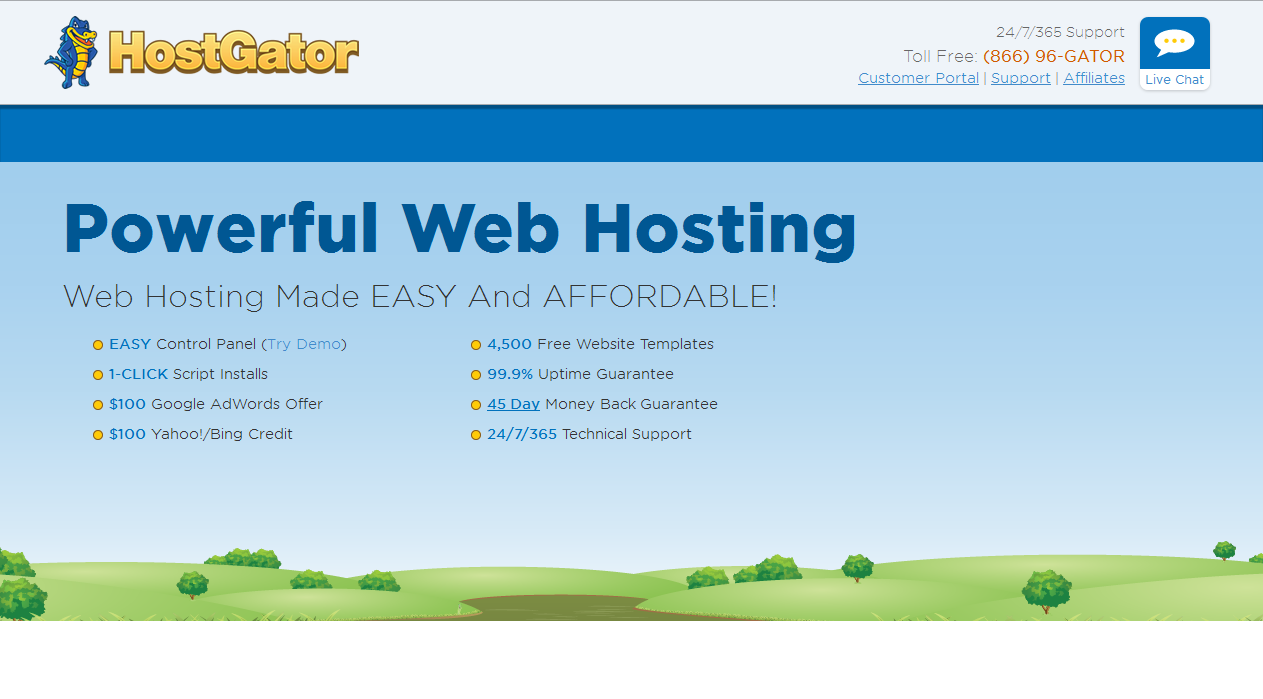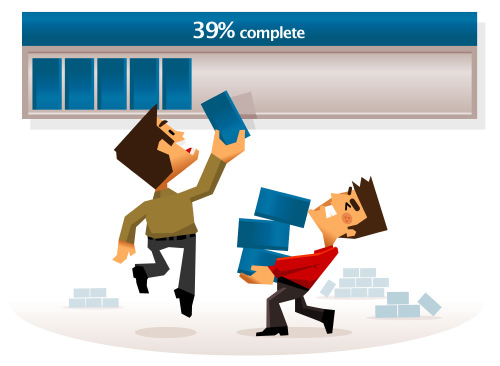Here is the step by step procedure to switch web hosts without having any down time.
Moving on to another host can be a quite difficult and time taking process. Follow this article that helps you switch smoothly with no interruptions,
Step 1: The initial step is to join your new web host. Make a point to DO NOT cancel with your old hosting provider, and don’t let them know you will be moving out. Keep this a secret from your old host, or they could recklessly end your site and cause downtime.
Step 2: Right now, you need to have hosting accounts with two hosting providers (the old and the new one). You will now move your whole site from the old host to the new one. This should be possible by interfacing with the old host’s FTP and downloading every one of your accounts, and after that by connecting with the new host’s FTP and transferring every one of your documents (keep up the same document and organizer structure). Few hosting providers like HostGator help you transfer your whole site for free of charge!

Step 3: You should likewise backup any databases on the old host (contact the old host for guidelines) and transfer the backup accounts to the new host through FTP. You should then restore your databases from those backup accounts; this should be possible by means of SSH or cPanel’s phpMyAdmin. Messages don’t typically transfer, however you can chronicle your messages from the old host. You can fulfill this by making a POP3 link with every email address; along these lines all the old messages are downloaded to your PC. The new host won’t have those old messages, however the new host will have the capacity to get new messages.
Step 4: Find out those hosting providers who could allow you to switch your whole site (documents and databases) for free of charge. Suppose, your old host utilized cPanel, they might have the capacity to switch the emails also.
Step 5: After you have a copy of your site on both hosting accounts, the time has come to change your domain name’s DNS….
Step 6: After you have every one of your documents on both hosting accounts, the time has come to change your area name’s DNS. Your new host will furnish you with the right name servers (DNS). You may need to contact the new host to discover what DNS settings you will use for your domain name.
DNS name servers generally seems as though this (displace “yourhostname.com” with your host’s real domain name):
ns1.yourhostname.com
ns2.yourhostname.com
When you have the right DNS, go to the hosting provider where you acquired your domain name to roll out the improvement. On the off chance that you bought your domain name from your host, you generally need to request that they roll out the DNS changes for you.
Step 7: Once your DNS changes have been made, you should hold up 48 hours (two days) before your site will stack from the new host. Amid this 48 hour period, your DNS is proliferating worldwide and your site will be haphazardly stacking from either the old host or the new host. Once the two days is finished, your site may be stacking from the new host.
Step 8: After the 48 hours have passed, your upgraded DNS will be completely utilitarian. You will now contact your old host and drop your hosting account with them. On the off chance that you initially purchased your area name from the old host, don’t drop your domain enrollment.
If you are done with all the above steps, you have effectively switched with no downtime without any interruptions.
Here are the 2 techniques that help you smoothly switch your host without downtime occurrence,
Advanced Techniques
There are different procedures for keeping away from downtime while switching the websites, and you will need to pick the technique most suitable for you and your site. A few techniques are more specialized and/or require more consideration than others.
DataBase: Your database(s) will be copied over to the new server as a part of the transfer process. If your database does not change much (for instance, it just changes when you add new presents or pages on your site), then there is little risk of lost data during the transfer process.
Then again, if you have a site where the database in always being changed with new data, for example, a website with loads of client produced content, you will need to take unique care to ensure no data is lost in the transfer process. There are a couple methods for doing this.
Have a look on below techniques,
Technique 1: Reconfigure the site on the old server to get to the database on the new server before changing the DNS.
One way to do it is you can arrange your site to interface with your new database, remotely; along these lines whether your audience are coordinated to the new site or the old site, all the new upgrades will be spared to the new database. Presently the new database will have the greater part of your present data and can keep on updating.
This system is the most specialized, yet would minimize downtime however much as could be expected for all guests to your site. You or your web originator would need to roll out improvements to your website amid the transfer to make this work.
The simple set of steps includes:
- Transfer all your accounts, databases and different settings over to the new server. (Through free content transfer or you transferring the documents yourself.)
- Test the site on the new server to ensure it fills in of course.
- (Suppose the changes have occurred at the database between steps 1 and 4, then re-transfer the latest form of the database. This step is pointless in the event that you do step 4 quickly after steps 1 and 2.)
- Change the database settings on your site so that the site on the old server gets to the database on the new server.
- Change the name servers and DNS to indicate the new server.
- Utilizing this system, it would not make any difference which server audience sees while the DNS spreads, subsequent to both the old server and new server updates the same database.
Technique 2: Disable updates to the database on the old server during the transfer.
Another strategy is to adjust your site on the old server so it doesn’t acknowledge overhauls to the database amid the transfer. Like the past technique, you or your web designer would need to roll out improvements to your website amid the transfer to make this work.
This strategy is best suitable if you are quickly advancing through the steps important to transfer, and/or wouldn’t fret if a few individuals incidentally see the old site while the DNS changes engender. This is additionally useful for websites where the database does not change that frequently on account of client info.
Contingent upon how your webpage is coded, this could mean putting the website into a read-just mode where individuals can see data however not roll out any changes, turning on support mode on your blog or CMS, or conceivably devastating the database all together and setting up a transitory page telling clients the website will be up presently.
You would do this quickly before transfer the most recent copy of the database over to the new server, and once that is finished, changing the name servers and DNS to indicate the new server.
While the DNS spreads (updates) around the world, a few individuals will see the site on the new server, and some will see the site on the old server, yet just the new server will acknowledge changes in the database.
A simple set of steps include:
- Transfer all your existing accounts, databases and different settings over to the new server. (By means of free content transfer or you transferring the documents yourself.)
- Test the site on the new server to ensure it fills in of course.
- On the old server, adjust your site so it can’t acknowledge changes to the database.
- (Suppose the changes have occurred at the database between steps 1 and 3, and then re-transfer the latest form of the database. This stride is superfluous on the off chance that you do step 3 quickly before or after step 1.)
- Change the name servers and DNS to indicate the new server.
- While the DNS spreads around the world, a few individuals will see the site on the new server, and some will see the site on the old server.
Few Tips on Reducing Propagation Time
- After the Content transfer, you can make an A file in your current DNS (On your old server) to divert all your audience to the new server; this is much quicker than sitting tight for the engendering of new name servers.
- Additionally, after the site transfer, you can make a MX account so your messages will all be conveyed to the new server and not have to sit tight as ache for engendering.
- When you have the A accounts and MX accounts overhauled to indicate the new server, you can change the name servers at whatever time.
Transfer Time Frame
The reality of the situation will become obvious eventually on how substantial is your transfer. (On the off chance that you require the content transfer speedier, or need more control of the transfer prepare, you may transfer the documents yourself as opposed to having us do it.)
The free transfer benefit does exclude any software, code or plan changes to your site that would should be made in the propelled procedures portrayed above (for instance, changing your database settings on the old site so both indicate the new database, or name server changes).
Fundamentally, the more control you need over the transfer process, the more links would be required of you or your web designer all the while.

